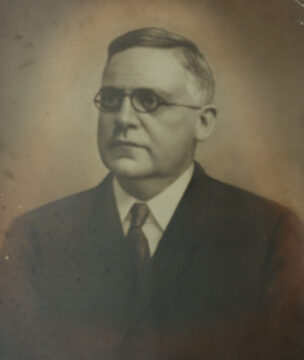
Living in a place with a history as rich as Galveston, it is easy to walk past a historic home or drive on a street named after a prominent family without giving it a second thought. Sometimes the legacy of a parent overshadows that of their children, or a family has so many important figures that they form one big historic amalgamation. While most of Galveston’s greatest philanthropists made their contributions for causes they cared passionately about, and not public recognition, it is important to know their stories and how their legacies were carried out. That’s why during February the Rosenberg Library Museum displayed items related to John Hutchings Sealy as the Treasure of the Month.
Growing the Empire
Born September 15, 1870 to Rebecca (Davis) and John Sealy in Galveston, John H. Sealy grew up on the island and was a member of the first graduating class of Ball High School in 1887. He went on earn his diploma from Princeton with honors and was the youngest graduate to that point. After a brief stint traveling abroad, Sealy returned to Galveston in 1891 to assume the role of full partner at Hutchings-Sealy Bank, an institution that his father, who died in 1884, cofounded.
In 1891 he was named a senior partner of the bank. The same year he was elected to succeed his uncle George Sealy as the president of the Gulf, Colorado and Santa Fe Railway and the Galveston Wharf Company. Sealy showed astute business acumen and spread his business holdings to hotels, construction, insurance and petroleum just to name a few. He founded Magnolia Petroleum Company which would eventually be absorbed by Standard Oil and is today part of Mobil Oil. At the time of his death in 1926, John Sealy II was said to be the wealthiest man in Texas.
Local Legacy
In 1900 the deadliest natural disaster in U.S. history struck Galveston, and the thirty-year-old Sealy seized the opportunity to assist his community and demonstrate his leadership abilities. He helped manage immediate relief operations and long-range planning and rebuilding. As the island transitioned back to normalcy Sealy served as the chairman of the Finance Commission and was instrumental in the construction of the Seawall and raising the grade of the island.

John Sealy II carried on the legacy of his family through his philanthropic endeavors. He and his sister Jennie Sealy Smith contributed an estimated $1 million of their personal funds to John Sealy Hospital (named for their father) and a woman’s hospital built in 1915. The two later established the Sealy-Smith Foundation to ensure the continued prosperity of the hospital.
Sealy was deeply involved with many other institutions in Galveston. He served as the treasurer of the Diocese of Texas of the Episcopal Church, Trustee of the Galveston city schools, founding board member and president of the Rosenberg Library, and a member of the University of Texas Board of Regents. He worked with both the Letitia Rosenberg Woman’s Home and the Galveston Orphan’s Home. When he died in February of 1926 the Galveston Daily News called him “one of the best known and most beloved citizens of Galveston.” He never married, and most of his estate was left to the Sealy-Smith Foundation which still exists today to support John Sealy Hospital.
Display
The February Treasure display included a studio portrait photo of John H. Sealy done in the famous Verkin Studio. Started by a German immigrant, Paul Verkin, and later included his sons Paul R., Mulvin and Louis, the studio is perhaps best known for its photos of the 1900 storm. However they also documented many other significant events like the grade raising and construction of the Seawall. In addition to the Rosenberg Library, the company’s photographs can be found in the Center for American History at The University of Texas at Austin.

Perhaps the most stunning item on display for February was a platinum Tiffany and Co. pocket watch owned by John Sealy donated by Lane Sealy in 2001. Its square shape is a nice contrast to most pocket watches of the 1910s – 1920s, which were round, and features a triangular bow where the fob would be attached. The face is simple with roman numerals and an understated Tiffany and Co. France. The back is engraved with John Sealy’s initials. The fob is attached to a black silk grosgrain ribbon which hangs from the watch by a gold chain, and was used for carrying the watch in a waistcoat or waistband pocket. The ribbon has a carnelian charm carved with an oriental design and framed in gold. The reverse side of the charm is flat and is also carved with Sealy’s initials.
Also on display is a sterling silver child’s drinking cup that Sealy gave to his godson Charles K. Peek, Jr. It is pear shaped with a stepped foot base and single scroll handle, and is in excellent condition for being 115 years old. It features a whimsical series of figures, animals, and items from various nursery rhymes including a cat playing a fiddle. It is engraved “Charles K. Peek, Jr. From His God Father John Sealy December 8, 1901.” The piece was donated in 2002 by Mr. Ben Peek Jr.